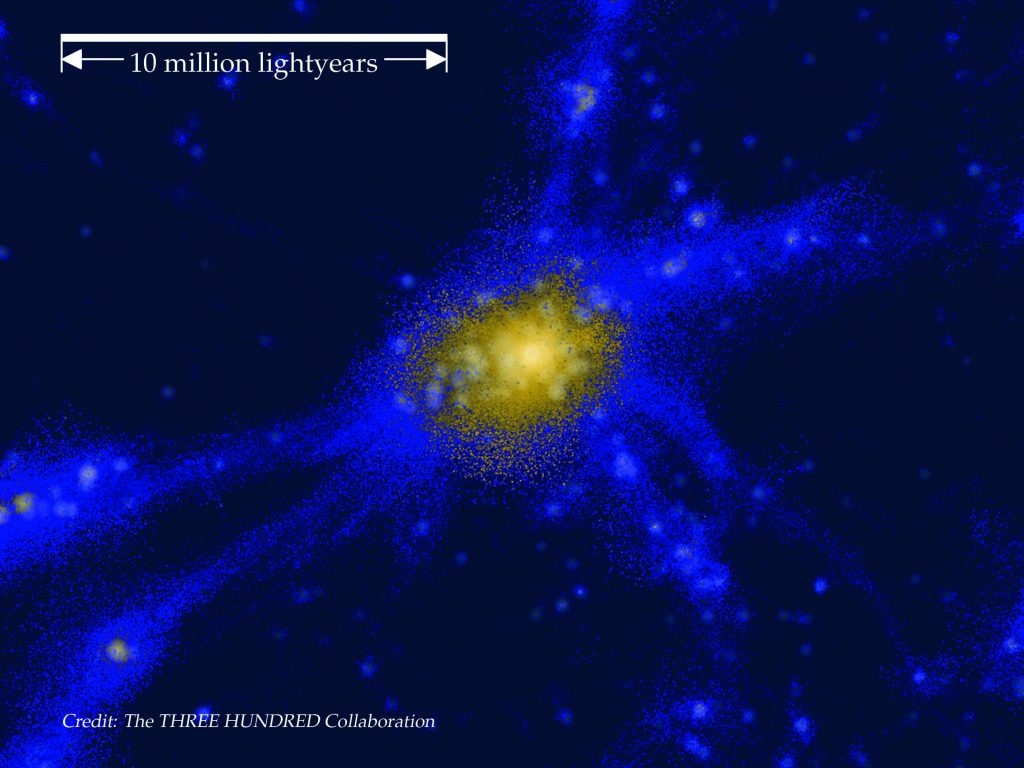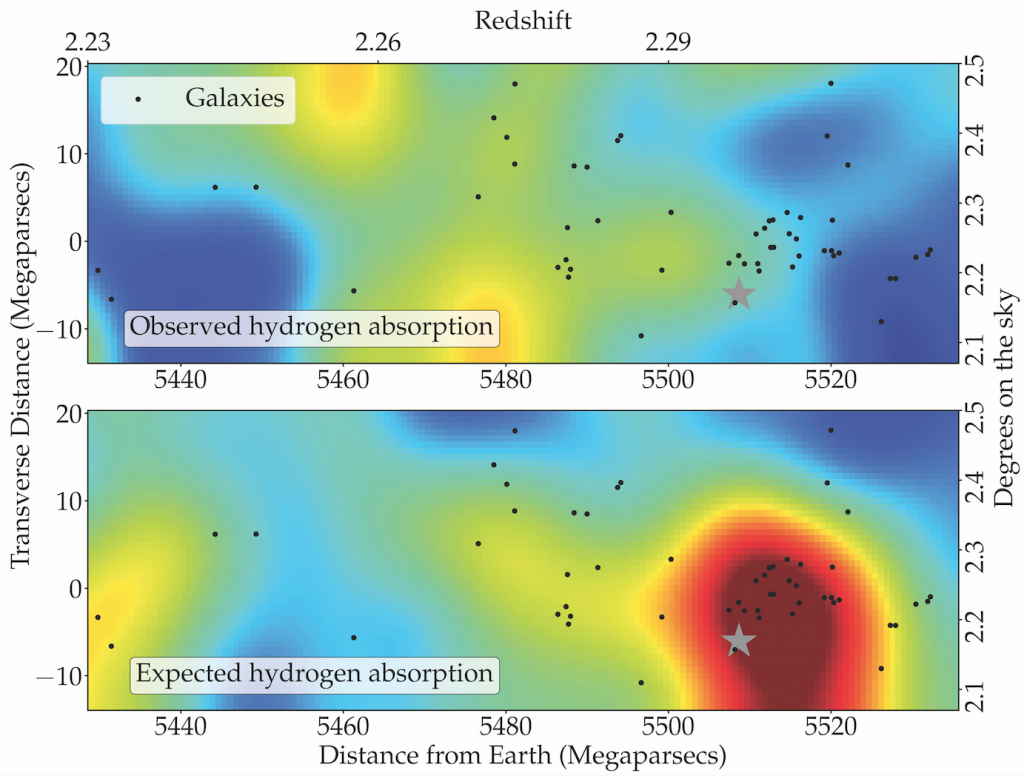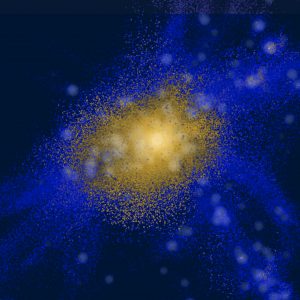Maunakea, Hawaiʻi – Astrophysicists using W. M. Keck Observatory on Maunakea in Hawaiʻi have discovered a galaxy protocluster in the early universe surrounded by gas that is surprisingly hot.
consists of a giant collection of galaxies called COSTCO-I. Observed when the universe was 11 billion years younger, COSTCO-I dates back to a time when the gas that filled most of the space outside of visible galaxies, called the intergalactic medium, was significantly cooler. During this era, known as ‘Cosmic Noon,’ galaxies in the universe were at the peak of forming stars; their stable environment was full of the cold gas they needed to form and grow, with temperatures measuring around 10,000 degrees Celsius.In contrast, the cauldron of gas associated with COSTCO-I seems ahead of its time, roasting in a hot, complex state; its temperatures resemble the present-day intergalactic medium, which sear from 100,000 to over 10 million degrees Celsius, often called the ‘Warm-Hot Intergalactic Medium’ (WHIM).
This discovery marks the first time astrophysicists have identified a patch of ancient gas showing characteristics of the modern-day intergalactic medium; it is by far the earliest known part of the universe that’s boiled up to temperatures of today’s WHIM.
The research, which is led by a team from the Kavli Institute for the Physics and Mathematics of the Universe (Kavli IPMU, part of the University of Tokyo), is published in today’s issue of The Astrophysical Journal Letters.
 A simulated visualization depicts the scenario of large-scale heating around a
A simulated visualization depicts the scenario of large-scale heating around a
galaxy protocluster, using data from supercomputer simulations. This is believed
to be a similar scenario to that observed in the COSTCO-I protocluster. The
yellow area in the center of the picture represents a huge, hot gas blob spanning
several million light years. The blue color indicates cooler gas located in the outer
regions of the protocluster and the filaments connecting the hot gas with other structures.
The white points embedded within the gas distribution is light emitted from stars. Simulation
Credit: The THREE HUNDRED Collaboration
“If we think about the present-day intergalactic medium as a gigantic cosmic stew that is boiling and frothing, then COSTCO-I is probably the first bubble that astronomers have observed, during an era in the distant past when most of the pot was still cold,” said Khee-Gan Lee, an assistant professor at Kavli IPMU and co-author of the paper.
The team observed COSTCO-I when the universe was only a quarter of its present age. The galaxy protocluster has a total mass of over 400 trillion times the mass of our Sun and spans several million light years.
While astronomers are now regularly discovering such distant galaxy protoclusters, the team found something strange when they checked the ultraviolet spectra covering COSTCO-I’s region using Keck Observatory’s Low Resolution Imaging Spectrometer (LRIS). Normally, the large mass and size of galaxy protoclusters would cast a shadow when viewed in the wavelengths specific to neutral hydrogen associated with the protocluster gas.
No such absorption shadow was found at the location of COSTCO-I.
“We were surprised because hydrogen absorption is one of the common ways to search for galaxy protoclusters, and other protoclusters near COSTCO-I do show this absorption signal,” said Chenze Dong, a Master’s degree student at the University of Tokyo and lead author of the study. “The sensitive ultraviolet capabilities of LRIS on the Keck I Telescope allowed us to make hydrogen gas maps with high confidence, and the signature of COSTCO-I simply wasn’t there.”
The absence of neutral hydrogen tracing the protocluster implies the gas in the protocluster must be heated to possibly million-degree temperatures, far above the cool state expected for the intergalactic medium at that distant epoch.
 This figure compares observed hydrogen absorption in vicinity of the COSTCO-I
This figure compares observed hydrogen absorption in vicinity of the COSTCO-I
galaxy protocluster (top panel), compared with the expected absorption given the
presence of the protocluster as computed from computer simulations. Strong
hydrogen absorption is shown in red, lower while weak absorption is shown in blue,
and intermediate absorption is denoted as green or yellow colors. The black dots
in the figure show where astronomers have detected galaxies in that area. At the
position of COSTCO-I (with its center marked as a star in both panels), astronomers
found that the observed hydrogen absorption is not of much different from the mean
value of the universe at that epoch. This is surprising because one would expect to
find extended hydrogen absorption spanning millions of light years in that region
corresponding to the high observed concentration of galaxies. This figure is adapted from the Dong et al.
2023 Astrophysical Journal Letters article. Credit: Dong et al.
“The properties and origin of the WHIM remains one of the biggest questions in astrophysics right now. To be able to glimpse at one of the early heating sites of the WHIM will help reveal the mechanisms that caused the intergalactic gas to boil up into the present-day froth,” said Lee. “There are a few possibilities for how this can happen, but it might be either from gas heating up as they collide with each other during gravitational collapse, or giant radio jets might be pumping energy from supermassive black holes within the protocluster.”
The intergalactic medium serves as the gas reservoir that feeds raw material into galaxies. Hot gas behaves differently from cold gas, which determines how easily they can stream into galaxies to form stars. As such, having the ability to directly study the growth of the WHIM in the early universe enables astronomers to build up a coherent picture of galaxy formation and the lifecycle of gas that fuels it.
ABOUT LRIS
The Low Resolution Imaging Spectrometer (LRIS) is a very versatile and ultra-sensitive visible-wavelength imager and spectrograph built at the California Institute of Technology by a team led by Prof. Bev Oke and Prof. Judy Cohen and commissioned in 1993. Since then it has seen two major upgrades to further enhance its capabilities: the addition of a second, blue arm optimized for shorter wavelengths of light and the installation of detectors that are much more sensitive at the longest (red) wavelengths. Each arm is optimized for the wavelengths it covers. This large range of wavelength coverage, combined with the instrument’s high sensitivity, allows the study of everything from comets (which have interesting features in the ultraviolet part of the spectrum), to the blue light from star formation, to the red light of very distant objects. LRIS also records the spectra of up to 50 objects simultaneously, especially useful for studies of clusters of galaxies in the most distant reaches, and earliest times, of the universe. LRIS was used in observing distant supernovae by astronomers who received the Nobel Prize in Physics in 2011 for research determining that the universe was speeding up in its expansion.
ABOUT W. M. KECK OBSERVATORY
The W. M. Keck Observatory telescopes are among the most scientifically productive on Earth. The two 10-meter optical/infrared telescopes atop Maunakea on the Island of Hawaii feature a suite of advanced instruments including imagers, multi-object spectrographs, high-resolution spectrographs, integral-field spectrometers, and world-leading laser guide star adaptive optics systems. Some of the data presented herein were obtained at Keck Observatory, which is a private 501(c) 3 non-profit organization operated as a scientific partnership among the California Institute of Technology, the University of California, and the National Aeronautics and Space Administration. The Observatory was made possible by the generous financial support of the W. M. Keck Foundation. The authors wish to recognize and acknowledge the very significant cultural role and reverence that the summit of Maunakea has always had within the Native Hawaiian community. We are most fortunate to have the opportunity to conduct observations from this mountain. Posted March 14, 2023
Posted March 14, 2023 OF A GALAXY PROTOCLUSTER SIMILAR TO COSTCO-I THAT IS SURROUNDED BY HOT GAS (YELLOW) BOILING AMID AN INTERGALACTIC MEDIUM FILLED WITH MUCH COOLER GAS (BLUE).
OF A GALAXY PROTOCLUSTER SIMILAR TO COSTCO-I THAT IS SURROUNDED BY HOT GAS (YELLOW) BOILING AMID AN INTERGALACTIC MEDIUM FILLED WITH MUCH COOLER GAS (BLUE).

-Horizontal-P301-w1920.png)
